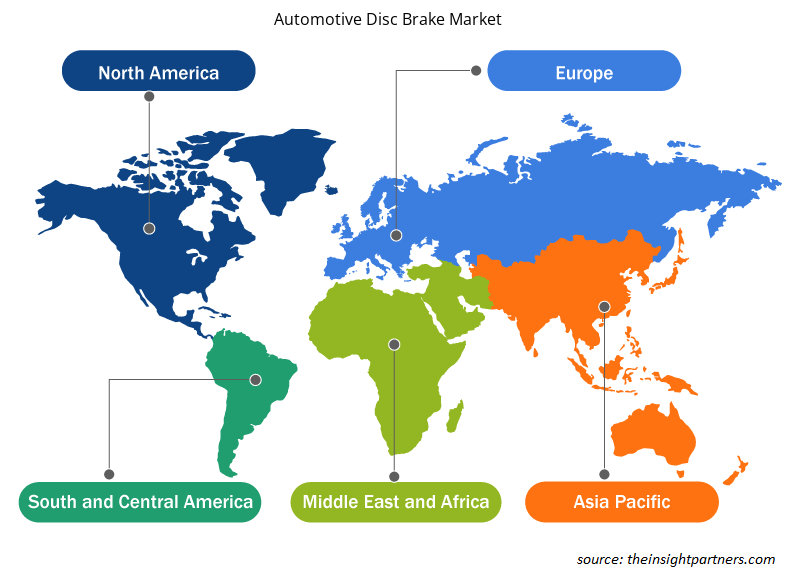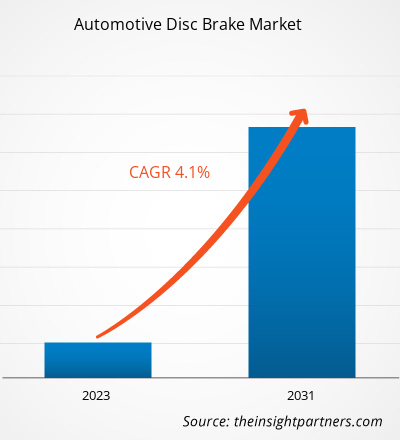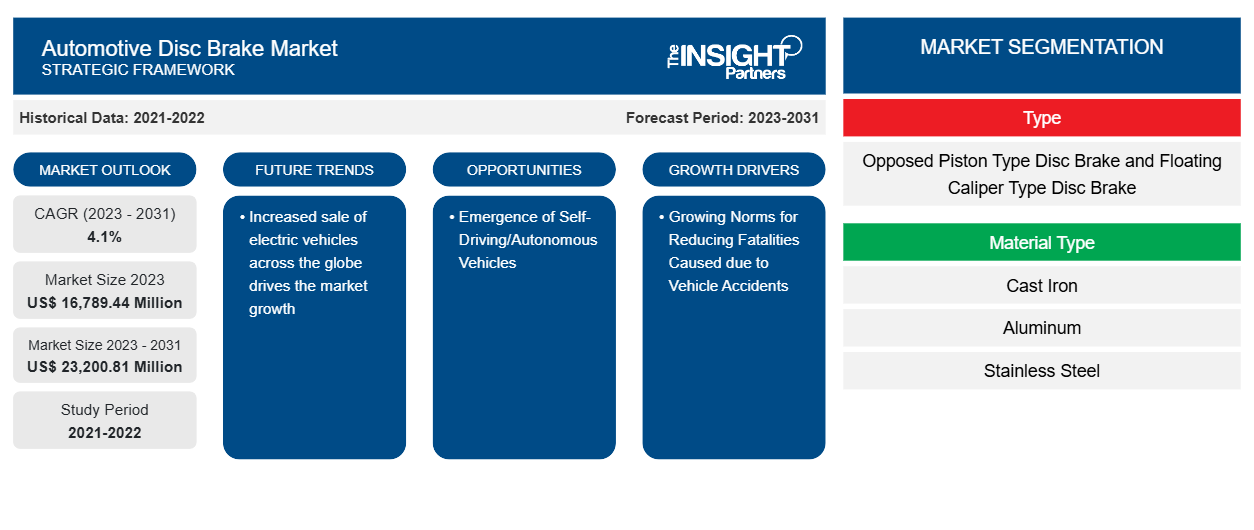Der Markt für Scheibenbremsen für Kraftfahrzeuge soll von 16.789,44 Millionen US-Dollar im Jahr 2023 auf 23.200,81 Millionen US-Dollar im Jahr 2031 anwachsen. Der Markt soll zwischen 2023 und 2031 eine durchschnittliche jährliche Wachstumsrate (CAGR) von 4,1 % verzeichnen. Die zunehmende Verbreitung selbstfahrender autonomer Fahrzeuge auf der ganzen Welt dürfte weiterhin ein wichtiger Markttrend bleiben. Selbstfahrende Autos gewinnen in Industrieländern wie den USA, Kanada, Deutschland und Großbritannien an Bedeutung. Die zunehmende Verbreitung vernetzter Fahrzeuge und die weltweite Verbreitung selbstfahrender Autos sind die wichtigsten Antriebsfaktoren für den Markt.
Marktanalyse für Scheibenbremsen für Kraftfahrzeuge
Zu den wichtigsten Stakeholdern im globalen Ökosystem des Marktes für Autoscheibenbremsen gehören Hardware-/Komponentenanbieter, Hersteller von Autoscheibenbremsen, Normungs- und Regulierungsgremien sowie Endverbraucher. Komponenten-/Hardwareanbieter liefern den Herstellern von Scheibenbremsen verschiedene Komponenten/Teile/Rohstoffe zur Herstellung des Endprodukts. Bremsbeläge, Entlüftungsschrauben, Bremssättel, Rotoren und Hardware. Neben den wichtigsten Akteuren des Ökosystems gibt es mehrere andere periphere Stakeholder, die am Markt beteiligt sind und eine entscheidende Rolle bei der Ermöglichung des Wachstums und der technologischen Fortschritte im Zusammenhang mit Autoscheibenbremsen spielen. Die steigende Zahl von Verkehrsunfällen aufgrund von Fahrzeugen erfordert Sicherheitsvorschriften, was wiederum den Bedarf an Bremssystemregeln und Verkehrssicherheit fördert. Zu diesen Stakeholdern gehören Regierungsbehörden, Industrieverbände, Technologienormungsorganisationen und Regulierungsbehörden, neben vielen anderen, die das Wachstum des globalen Marktes für Autoscheibenbremsen fördern. Zu den wichtigsten Endverbrauchern des Marktes für Autoscheibenbremsen gehören Personenkraftwagen und Nutzfahrzeuge
Marktübersicht für Scheibenbremsen für Kraftfahrzeuge
Die Scheibenbremse besteht aus Gusseisen, Aluminium, Edelstahl und vielen weiteren Materialien. Zu den wichtigsten Marktteilnehmern/Herstellern auf dem globalen Markt für Scheibenbremsen für Kraftfahrzeuge zählen unter anderem Thermo Fisher Scientific Inc., Brembo SPA, Continental AG, Knorr-Bremse Group und Robert Bosch GmbH. Scheibenbremsen für Kraftfahrzeuge werden hauptsächlich in Personenkraftwagen eingesetzt , aufgrund ihrer stabilen Leistung bei Bremswiderstand und höheren Geschwindigkeiten finden sie jedoch zunehmend auch im Nutzfahrzeugsegment Verwendung. In Nutzfahrzeugen werden Trommelbremsen durch Scheibenbremsen ersetzt, da sie eine höhere Qualität und eine längere Lebensdauer bieten. Unternehmen wie Akebono bieten ebenfalls Scheibenbremsen an.
Passen Sie diesen Bericht Ihren Anforderungen an
Sie erhalten kostenlos individuelle Anpassungen an jedem Bericht, einschließlich Teilen dieses Berichts oder einer Analyse auf Länderebene, eines Excel-Datenpakets sowie tolle Angebote und Rabatte für Start-ups und Universitäten.
-
Holen Sie sich die wichtigsten Markttrends aus diesem Bericht.Dieses KOSTENLOSE Beispiel umfasst eine Datenanalyse von Markttrends bis hin zu Schätzungen und Prognosen.
Treiber und Chancen auf dem Automobil-Scheibenbremsenmarkt
Wachsende Normen zur Reduzierung der durch Autounfälle verursachten Todesfälle
Die steigenden Verkaufszahlen von Pkw und Nutzfahrzeugen kurbeln das Wachstum des Bremsenmarktes weltweit an. Die steigende Nachfrage nach Fahrzeugen wirkt sich weltweit positiv auf deren Produktionszyklus aus. Da die Nachfrage nach Fahrzeugen steigt, werden zunehmend gesetzliche Vorschriften erlassen, um die Fahrzeuge sicherer zu machen. Dies führt zu einem Anstieg der Nachfrage nach Bremsen. Die Verbreitung von Antiblockiersystemen und elektronischen Stabilitätskontrollsystemen nimmt zu. Daher haben Regierungsbehörden in Ländern wie Indien Schritte unternommen, um sicherheitskritische Komponenten in Nutzfahrzeugen und Pkw zu regulieren, was zu einer steigenden Nachfrage nach Antiblockiersystemen geführt hat.
Aufkommen selbstfahrender/autonomer Fahrzeuge
Autohersteller und Technologieunternehmen entwickeln hochentwickelte Technologien, die es Autos ermöglichen, selbst zu fahren. Im Rennen um die Erprobung selbstfahrender Fahrzeuge liegt Google an der Spitze, gefolgt von Audi, Toyota und Mercedes-Benz. Darüber hinaus prognostiziert das Institute of Electrical and Electronics Engineers (IEEE), dass selbstfahrende Fahrzeuge bis 2040 etwa 75 % aller Fahrzeuge auf den Straßen ausmachen werden. Man geht davon aus, dass die Branche der selbstfahrenden Autos dem Entwicklungszyklus der Bremstechnologien zugutekommt. Neben der zunehmenden Zahl selbstfahrender Fahrzeuge sind veränderte staatliche Vorschriften und Kooperationen einige der wichtigsten Trends, die den Wandel der Autoindustrie unterstützen werden. Aufgrund staatlicher Vorschriften zur Sicherheit von Fahrern und Passagieren testen derzeit weltweit mindestens 47 Städte selbstfahrende Autos. Mit der Entstehung selbstfahrender/ autonomer Fahrzeuge wird sich der Markt für Bremssysteme weiterentwickeln.
Segmentierungsanalyse des Marktberichts für Scheibenbremsen für Kraftfahrzeuge
Wichtige Segmente, die zur Ableitung der Marktanalyse für Automobil-Scheibenbremsen beigetragen haben, sind Typ, Materialtyp und Fahrzeugtyp.
- Je nach Typ gibt es auf dem Markt Scheibenbremsen mit Kolben- und Schwimmsattel-Typ. Unter diesen wird die Schwimmsattel-Typ-Scheibenbremse im Jahr 2023 den größten Anteil haben, da sie zunehmend in Pkws eingesetzt wird.
- Je nach Materialtyp ist der Markt in Gusseisen, Aluminium, Edelstahl und andere unterteilt. Unter diesen wird Aluminium voraussichtlich im Jahr 2023 den größten Anteil haben, was auf sein geringes Gewicht und seine höhere Zuverlässigkeit zurückzuführen ist.
- Basierend auf dem Fahrzeugtyp ist der Markt in Personenkraftwagen, leichte Nutzfahrzeuge (LCVs) und schwere Nutzfahrzeuge (HCVs) unterteilt. Unter diesen haben Personenkraftwagen im Jahr 2023 den größten Anteil, was auf den weltweit gestiegenen Pkw-Verkauf zurückzuführen ist. Laut der Internationalen Energieagentur erreichte der Pkw-Verkauf im Jahr 2023 65,27 Millionen, ein Anstieg von 58,2 Millionen Einheiten im Jahr 2022. Dieses schnelle Wachstum beim Pkw-Verkauf hat im Prognosezeitraum eine enorme Nachfrage nach dem Markt für Kfz-Scheibenbremsen geschaffen.
Marktanteilsanalyse für Scheibenbremsen für Kraftfahrzeuge nach geografischen Gesichtspunkten
Der geografische Umfang des Marktberichts für Kfz-Scheibenbremsen ist hauptsächlich in fünf Regionen unterteilt: Nordamerika, Asien-Pazifik, Europa, Naher Osten und Afrika sowie Süd- und Mittelamerika.
Der asiatisch-pazifische Raum dürfte 2023 den größten Anteil haben, was auf die gestiegene Produktion von Automobilkomponenten in China, Indien und Japan zurückzuführen ist. Diese Länder investieren große Summen in die Produktion von Automobilkomponenten, um die weltweit wachsende Nachfrage nach neuen Fahrzeugen zu decken. Laut der Internationalen Energieagentur erreichte die Automobilproduktion im asiatisch-pazifischen Raum im Jahr 2023 51,8 Millionen, was einem Anstieg von 10 % gegenüber dem Vorjahr entspricht. Die robuste Automobilproduktion findet in Indien, China und Japan statt. Dieses Wachstum der Automobilproduktion im asiatisch-pazifischen Raum treibt das Wachstum des Marktes für Automobilscheibenbremsen im Prognosezeitraum an.
Regionale Einblicke in den Markt für Scheibenbremsen für Kraftfahrzeuge
Die regionalen Trends und Faktoren, die den Markt für Scheibenbremsen für Kraftfahrzeuge im Prognosezeitraum beeinflussen, wurden von den Analysten von Insight Partners ausführlich erläutert. In diesem Abschnitt werden auch die Marktsegmente und die Geografie für Scheibenbremsen für Kraftfahrzeuge in Nordamerika, Europa, im asiatisch-pazifischen Raum, im Nahen Osten und Afrika sowie in Süd- und Mittelamerika erörtert.

- Erhalten Sie regionale Daten zum Markt für Scheibenbremsen für Kraftfahrzeuge
Umfang des Marktberichts zu Scheibenbremsen für Kraftfahrzeuge
| Berichtsattribut | Details |
|---|---|
| Marktgröße im Jahr 2023 | 16.789,44 Millionen US-Dollar |
| Marktgröße bis 2031 | 23.200,81 Millionen US-Dollar |
| Globale CAGR (2023 - 2031) | 4,1 % |
| Historische Daten | 2021-2022 |
| Prognosezeitraum | 2023–2031 |
| Abgedeckte Segmente |
Nach Typ
|
| Abgedeckte Regionen und Länder |
Nordamerika
|
| Marktführer und wichtige Unternehmensprofile |
|
Marktteilnehmerdichte: Der Einfluss auf die Geschäftsdynamik
Der Markt für Scheibenbremsen für Kraftfahrzeuge wächst rasant. Dies wird durch die steigende Nachfrage der Endnutzer aufgrund von Faktoren wie sich entwickelnden Verbraucherpräferenzen, technologischen Fortschritten und einem größeren Bewusstsein für die Vorteile des Produkts vorangetrieben. Mit der steigenden Nachfrage erweitern Unternehmen ihr Angebot, entwickeln Innovationen, um die Bedürfnisse der Verbraucher zu erfüllen, und nutzen neue Trends, was das Marktwachstum weiter ankurbelt.
Die Marktteilnehmerdichte bezieht sich auf die Verteilung der Firmen oder Unternehmen, die in einem bestimmten Markt oder einer bestimmten Branche tätig sind. Sie gibt an, wie viele Wettbewerber (Marktteilnehmer) in einem bestimmten Marktraum im Verhältnis zu seiner Größe oder seinem gesamten Marktwert präsent sind.
Die wichtigsten auf dem Markt für Kfz-Scheibenbremsen tätigen Unternehmen sind:
- Brembo SpA
- Continental AG
- Delphi Technologies (BorgWarner Inc.)
- EBC-Bremsen
- Haldex-Gruppe
- Hitachi Automotive Systems Amerika
Haftungsausschluss : Die oben aufgeführten Unternehmen sind nicht in einer bestimmten Reihenfolge aufgeführt.

- Überblick über die wichtigsten Akteure auf dem Markt für Kfz-Scheibenbremsen
Neuigkeiten und aktuelle Entwicklungen zum Markt für Scheibenbremsen für Kraftfahrzeuge
Der Markt für Scheibenbremsen für Kraftfahrzeuge wird durch die Erhebung qualitativer und quantitativer Daten nach Primär- und Sekundärforschung bewertet, die wichtige Unternehmensveröffentlichungen, Verbandsdaten und Datenbanken umfasst. Nachfolgend sind einige der Entwicklungen auf dem Markt für Scheibenbremsen für Kraftfahrzeuge aufgeführt:
- ADVICS, der führende Anbieter fortschrittlicher Bremstechnologie und Mitglied der AISIN-Unternehmensgruppe, erweitert seine Produktlinie an Bremsscheiben um rund 28 Millionen Stück für die Achsenabdeckung von in Betrieb befindlichen Fahrzeugen (VIO). Jede der 67 Bremsscheiben ist zertifiziert kohlenstoffhaltig und vollständig beschichtet und bietet erstklassigen Schutz gegen Rost und Korrosion. (Quelle: ADVICS-Newsletter, Oktober 2022)
- ZF Aftermarket setzt seine Expansion in Indien fort und das Land wird durch seine Produktionsstätte in der Region zu einem Zentrum für TRWs Kompetenz in der Stoßdämpferherstellung. ZF Aftermarket hat durch die Einführung von TRW-Stoßdämpfern, Bremsbelägen und Bremsscheiben bedeutende Fortschritte bei der Erweiterung seines Produkt- und Lösungsangebots für den indischen Markt gemacht. Im Einklang mit seiner Verpflichtung „Make in India“ für Indien konzentriert sich ZF nun darauf, seine TRW-Stoßdämpferfertigungskapazitäten in Indien zu stärken, wobei der Schwerpunkt auf dem Aufbau eines hochqualifizierten Talentpools liegt, um im Land nicht nur zu produzieren, sondern auch zu forschen, zu entwickeln und zu konstruieren. (Quelle: Newsletter der ZF Friedrichshafen AG, Februar 2024)
Marktbericht zu Scheibenbremsen für Kraftfahrzeuge – Umfang und Ergebnisse
Der Bericht „Marktgröße und Prognose für Scheibenbremsen für Kraftfahrzeuge (2021–2031)“ bietet eine detaillierte Analyse des Marktes, die die folgenden Bereiche abdeckt:
- Marktgröße und Prognose für Scheibenbremsen für Kraftfahrzeuge auf globaler, regionaler und Länderebene für alle wichtigen Marktsegmente, die im Rahmen des Berichts abgedeckt sind
- Markttrends für Scheibenbremsen für Kraftfahrzeuge sowie Marktdynamik wie Treiber, Einschränkungen und wichtige Chancen
- Detaillierte PEST- und SWOT-Analyse
- Analyse des Marktes für Scheibenbremsen für Kraftfahrzeuge, einschließlich wichtiger Markttrends, globaler und regionaler Rahmenbedingungen, wichtiger Akteure, Vorschriften und aktueller Marktentwicklungen
- Branchenlandschaft und Wettbewerbsanalyse, die die Marktkonzentration, Heatmap-Analyse, prominente Akteure und aktuelle Entwicklungen auf dem Markt für Kfz-Scheibenbremsen umfasst
- Detaillierte Firmenprofile
- Historische Analyse (2 Jahre), Basisjahr, Prognose (7 Jahre) mit CAGR
- PEST- und SWOT-Analyse
- Marktgröße Wert/Volumen – Global, Regional, Land
- Branchen- und Wettbewerbslandschaft
- Excel-Datensatz
Aktuelle Berichte
Erfahrungsberichte
Grund zum Kauf
- Fundierte Entscheidungsfindung
- Marktdynamik verstehen
- Wettbewerbsanalyse
- Kundeneinblicke
- Marktprognosen
- Risikominimierung
- Strategische Planung
- Investitionsbegründung
- Identifizierung neuer Märkte
- Verbesserung von Marketingstrategien
- Steigerung der Betriebseffizienz
- Anpassung an regulatorische Trends























 Kostenlose Probe anfordern für - Markt für Kfz-Scheibenbremsen
Kostenlose Probe anfordern für - Markt für Kfz-Scheibenbremsen